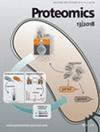转化肽类激素预测:人工智能在现代蛋白质组学中的作用。
IF 3.4
4区 生物学
Q2 BIOCHEMICAL RESEARCH METHODS
引用次数: 0
摘要
本文章由计算机程序翻译,如有差异,请以英文原文为准。
Transforming peptide hormone prediction: The role of AI in modern proteomics
求助全文
通过发布文献求助,成功后即可免费获取论文全文。
去求助
来源期刊

Proteomics
生物-生化研究方法
CiteScore
6.30
自引率
5.90%
发文量
193
审稿时长
3 months
期刊介绍:
PROTEOMICS is the premier international source for information on all aspects of applications and technologies, including software, in proteomics and other "omics". The journal includes but is not limited to proteomics, genomics, transcriptomics, metabolomics and lipidomics, and systems biology approaches. Papers describing novel applications of proteomics and integration of multi-omics data and approaches are especially welcome.
 求助内容:
求助内容: 应助结果提醒方式:
应助结果提醒方式:


